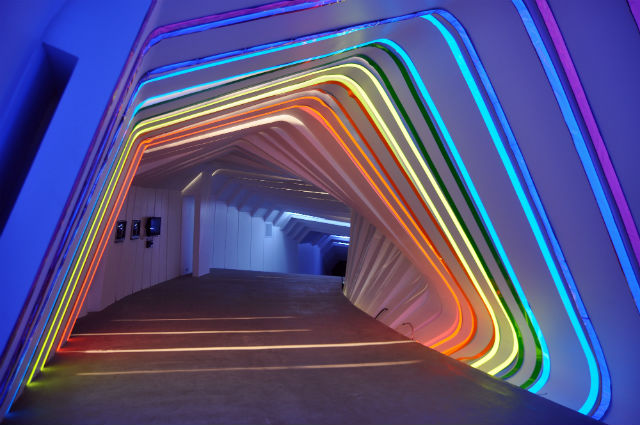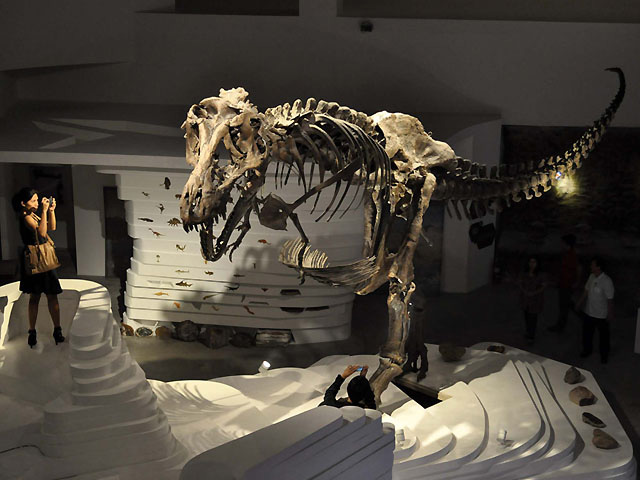Filtered by: Scitech
SciTech
Mind over matter: Some thoughts on The Mind Museum
By Patricia Calzo Vega
When The Mind Museum in Taguig opens its doors on March 16, it will join only a handful of institutions dedicated to the public understanding of science, including the Philippine Science Centrum, the Nido Fortified Science Discovery Center, and the rice-themed IRRI Museum.
It will likely become a field trip favorite, at first because of its sheer novelty, but will hopefully sustain interest because it holds infinitely more educational value than, say, Enchanted Kingdom or an SM supermall, both of which have served as a site for many a school-sanctioned excursion.
Building a scientific tradition
 “This is education, not entertainment.” Manny Blas, managing director of the Bonifacio Art Foundation Inc., which operates the science museum, is quick to point this out at the preview held for members of the media and their families. Museum visitors should expect to learn a thing or two from the over 250 exhibits—most of them interactive—housed inside.
“This is education, not entertainment.” Manny Blas, managing director of the Bonifacio Art Foundation Inc., which operates the science museum, is quick to point this out at the preview held for members of the media and their families. Museum visitors should expect to learn a thing or two from the over 250 exhibits—most of them interactive—housed inside. With its primarily experiential nature, The Mind Museum bears more similarity to the Science Centre Singapore, which served as a consultant during the planning stages, than early modern science museum pioneers such as The Science Museum in London and the Museum of Science and Industry in Chicago. In addition to the interactive displays that characterize contemporary science museums, these institutions house sprawling exhibits on the scientific tradition in their respective countries. This is in no small part due to centuries of Western philosophy’s fascination with the ideas of science, knowledge, and truth, and its representations; as institutions established by government (and to this day still receive some public funding), these museums are also viewed as symbols of national identity and progress.
For a country like the Philippines, with its less prevalent scientific culture, science museums necessarily take on the quixotic project of creating public interest in the sciences. “Science is too important to leave to scientists alone, we all have to be able to understand it ourselves,” says Mind Museum curator Maribel Garcia.
The order of things
 The museum is housed in a brand-new, two-storey structure designed by Lor Calma and Associates. Mindful of the institution’s role as a science education facility, Architect Ed Calma took inspiration from nature, creating a futuristic yet organic design imbued with green architectural features that promote energy efficiency and maximize rainwater collection. In a statement, Calma says that his vision is “to encourage the public to view science and art in a different light…to help them see the interconnections [between] these two fields.”
The museum is housed in a brand-new, two-storey structure designed by Lor Calma and Associates. Mindful of the institution’s role as a science education facility, Architect Ed Calma took inspiration from nature, creating a futuristic yet organic design imbued with green architectural features that promote energy efficiency and maximize rainwater collection. In a statement, Calma says that his vision is “to encourage the public to view science and art in a different light…to help them see the interconnections [between] these two fields.” The first floor houses four galleries dedicated to different aspects of science. Upon entry, visitors are greeted by the robot Adei (a play on the word, “idea”); the area flows into the Ten Most Beautiful Experiments exhibit inspired by Robert Crease’s The Prism and the Pendulum, and onwards to the Hall of Philippine Science. That these are exhibited in the “must-pass” areas is rather fitting as a nod to the possibilities of technological advancement, an homage to the classical scientists and their understanding of the physical world, and an appeal to strengthen and expand the local scientific community.
Hodgepodge of Philippine science
That said, the Hall of Philippine Science is a hodgepodge of concepts that relate science and Philippine society: an exhibit on prominent Filipino scientists and how they got into their fields, biodiversity and conservation, rice production and climate change, and sustainability and upcycling. Perhaps, as local interest in the sciences grows, the Hall of Philippine Science will also expand and take on a more cohesive form. For now, the Filipino connection to science is highlighted more through the craftsmanship of the exhibits. Blas points out that 90% of The Mind Museum was built by a Filipino team of scientists and artists, who have taken great pains to ensure that the exhibitions are both scientifically accurate and aesthetically pleasing, and have met with the standards of international science museum experts.
After these “must-pass” areas, museum guests can proceed to the Atom, Life, Earth, and Universe galleries. There is no required way to navigate The Mind Museum —visitors can go about as they please, but are definitely encouraged to tinker with the exhibits and experience science firsthand. Guides, called Mind Movers, are on hand and answer any questions that guests may have, and encourage further discussion. “Ultimately, science is about understanding things [for/by] yourself,” says Garcia.
 The Atom Gallery focuses on the invisible structures that govern the physical world. Physics and chemistry principles are demonstrated through fun, interactive displays: the Whirlpool exhibit (centripetal force), Van de Graff ball (Static electricity), and Carbon game area (do-it-yourself allotropes) drew a lot of attention.
The Atom Gallery focuses on the invisible structures that govern the physical world. Physics and chemistry principles are demonstrated through fun, interactive displays: the Whirlpool exhibit (centripetal force), Van de Graff ball (Static electricity), and Carbon game area (do-it-yourself allotropes) drew a lot of attention. The Life Gallery houses exhibits on all aspects of life: from the Web of Life (which displays interconnections between various organisms in an ecosystem) to amino acids and cells, to giant models of the human brain and the Butanding (whale shark). Because it encompasses multiple branches of biology and the natural sciences, the gallery can be overwhelming and slightly unorganized, but nonetheless remains riveting because of its interactivity.
 Stan, the T. Rex model, looms over the Earth Gallery, which focuses on the earth sciences and natural history. The dioramas on mass extinction and the scale models of hominids are among the Filipino-handcrafted exhibits handcrafted that gained kudos from international experts. It also includes a model volcano—ready to erupt at the press of a button—and a live feed of atmospheric and geophysical data projected onto a floating globe.
Stan, the T. Rex model, looms over the Earth Gallery, which focuses on the earth sciences and natural history. The dioramas on mass extinction and the scale models of hominids are among the Filipino-handcrafted exhibits handcrafted that gained kudos from international experts. It also includes a model volcano—ready to erupt at the press of a button—and a live feed of atmospheric and geophysical data projected onto a floating globe. Last but not least of the ground-floor exhibits is the Universe Gallery capped by a simulation of the constellations of the Northern and Southern hemispheres. The highlight of this gallery is the Spaceshell, a mini-planetarium where guests can lie down and observe the night sky, or watch films about the planets, space travel, and the possibility of extraterrestrial life.
 The Technology Gallery is located on the second floor. This again demonstrates just how well-thought out the museum layout is. After learning about basic science concepts, visitors can better appreciate how these principles are applied and how we now enjoy the fruits of scientific progress.
The Technology Gallery is located on the second floor. This again demonstrates just how well-thought out the museum layout is. After learning about basic science concepts, visitors can better appreciate how these principles are applied and how we now enjoy the fruits of scientific progress. The gallery is a celebration of all the things that make us human: transportation and infrastructure, agriculture, energy, clothing and packaging, science’s contribution to the arts, even everyday processes like fermentation and plumbing. Having moved on to the realm of material culture, the value judgments of the curatorial staff are more evident, such as, say choosing to feature both The Cure’s “Love Song” and KC &Jo-jo’s “All My Life” as examples of Songs about Love.
Public understanding, private spending
The Mind Museum at Taguig is a non-profit organization fully funded by private donations. Some of these are from individuals and families but majority are shouldered by corporations who lend their name (quite unobtrusively) to selected exhibits. These exhibits are directly related to the sponsors’ respective industries, such as the taste display for Ajinomoto and the entire energy section shared by Pilipinas Shell and Chevron-Department of Energy-PNOC. While this could point to the high level of expertise behind the development of the exhibit, more critically-minded visitors could also question the motivations behind the sponsorship, especially if the exhibit comes across as one sided.
Social anthropologist Sharon MacDonald, who has published extensively on science museums, notes that “lay response to scientific information is dependent on the trustworthiness of the source.” Museums in general are viewed as gatekeepers of knowledge—and the need to generate funding through private sources is generally accepted by the public—so for as long as The Mind Museum exercises due diligence in corporate fundraising and in developing exhibits that present both positive and negative impacts of science and technology, visitors should have no problem accepting the accuracy of their exhibits,
Despite receiving funding from a variety of sources, admission costs to The Mind Museum are quite prohibitive, at 600 PhP for adults and PhP 450 for private school students; entrance costs for public school students and teachers (from both public and private schools) are subsidized at PhP150. Admission covers three hours in the museum—crowds are limited to ensure that guests are able to fully enjoy all the interactive exhibits—and an all-day pass costs 750 PhP.
Blas is quick to defend the museum’s entrance fees, noting that the experience is well worth the price. “If some of you think that [museum admission] is expensive, I think ignorance is [more] expensive.”
Looking forward
That said, The Mind Museum is not meant to be a substitute for actual science education, but instead aims to strengthen scientific literacy so that students get more interested in their science subjects once in school.
“Our schools do not have enough time to impress [on students] how fun [science] can be,” says Emily Abrera, who chairs the Museum’s Exhibit Advisory Council.
Engaging children and teenagers will, hopefully, redound to greater interest in pursuing degrees in cience and technology, which is where majority of government spending in science education lies: the Department of Science and Technology currently has 12,000 scholars, with numbers expected to rise with the approved increase in annual funding.
It remains to be seen whether The Mind Museum will be successful in this regard, but getting there is surely a fun, learning experience. — TJD/HS, GMA News
For further reading on the function of science museums and the representations of knowledge therein:
More Videos
Most Popular




